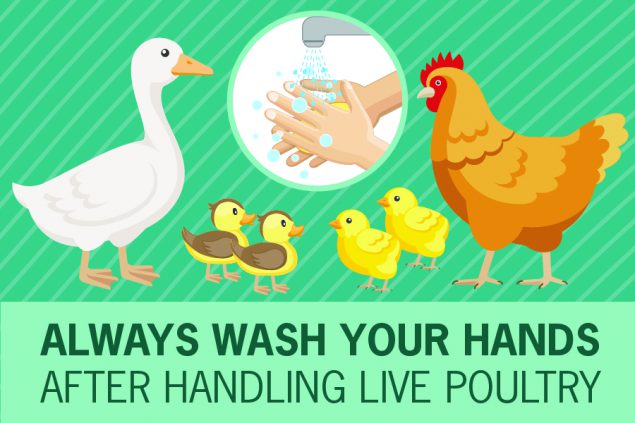2018 Salmonella Infections Linked to Contact with Live Poultry in Backyard Flocks, 2018 (Final Update)
Posted September 13, 2018 at 11:00 AM ET
These outbreak investigations are over. However, people can still get a Salmonella infection from live poultry, including those in backyard flocks. Read more information about Salmonella from live poultry and how people can reduce the chance they or their children will get an infection.
Final Outbreak Advisory
334
Cases
47
States
56
Hospitalizations
0
Deaths
- CDC and multiple states investigated several multistate outbreaks of Salmonella infections linked to contact with live poultry in backyard flocks.
- People can get sick with Salmonella infections from touching live poultry or their environment. These birds can be carrying Salmonella bacteria but appear healthy and clean and show no signs of illness.
- Several different types of Salmonella bacteria have made people sick in these outbreaks: Salmonella Seftenberg, Salmonella Montevideo, Salmonella Infantis, Salmonella Enteritidis, Salmonella Indiana, and Salmonella Litchfield.
- A total of 334 people were infected with the outbreak strains of Salmonella reported from 47 states.
- Illnesses started from February 15, 2018 to August 10, 2018.
- 56 ill people were hospitalized, and no deaths were reported.
- 21% of ill people were children younger than 5 years.
- Epidemiologic, traceback, and laboratory findings linked these outbreaks to contact with live poultry, such as chicks and ducklings, which came from multiple hatcheries.
- In interviews, 132 (63%) of 211 ill people with information available reported contact with chicks or ducklings in the week before their illness started.
- People reported obtaining chicks and ducklings from several sources, including feed supply stores, websites, hatcheries, and from relatives.
- Whole genome sequencing analysis was performed on 141 isolates from ill people in this outbreak. Twenty-eight isolates contained genes that predict resistance to at least one of the following antibiotics: ampicillin, streptomycin, sulfamethoxazole, tetracycline, gentamicin, ceftriaxone, amoxicillin-clavulanic acid, cefoxitin, ciprofloxacin, and fosfomycin. No resistance was identified in 113 isolates. Testing of 6 isolates using standard antibiotic susceptibility testing by CDC’s National Antimicrobial Resistance Monitoring System (NARMS) laboratory confirmed these results. Some of these antibiotic-resistant infections may be difficult to treat with the commonly recommended antibiotics, and may require a different antibiotic choice.
- These outbreak investigations are over. CDC will continue to work with state public health partners to monitor for the occurrence of Salmonella infections associated with contact with live poultry in backyard flocks.
Previous Outbreak Advisories

Tips to Stay Healthy With a Backyard Flock
- Always wash hands thoroughly with soap and water right after touching live poultry or anything in their environment.
- Don’t let children younger than 5 years handle or touch live poultry without adult supervision.
- Set aside a pair of shoes to wear while taking care of your birds and keep the shoes outside of your home.
Read more about ways to stay healthy with backyard flocks. Read live poultry Q&A.

Seventy outbreaks of Salmonella infections have been linked to contact with backyard flocks since 2000 [PDF – 887 KB].
